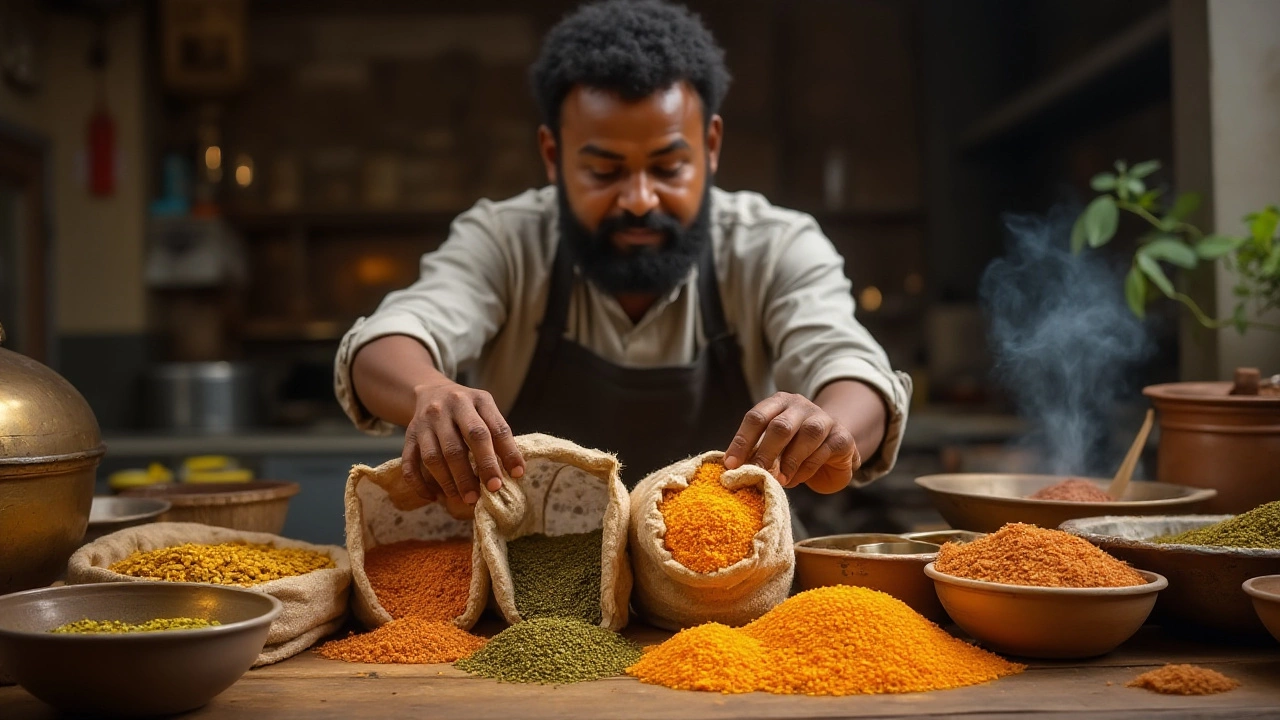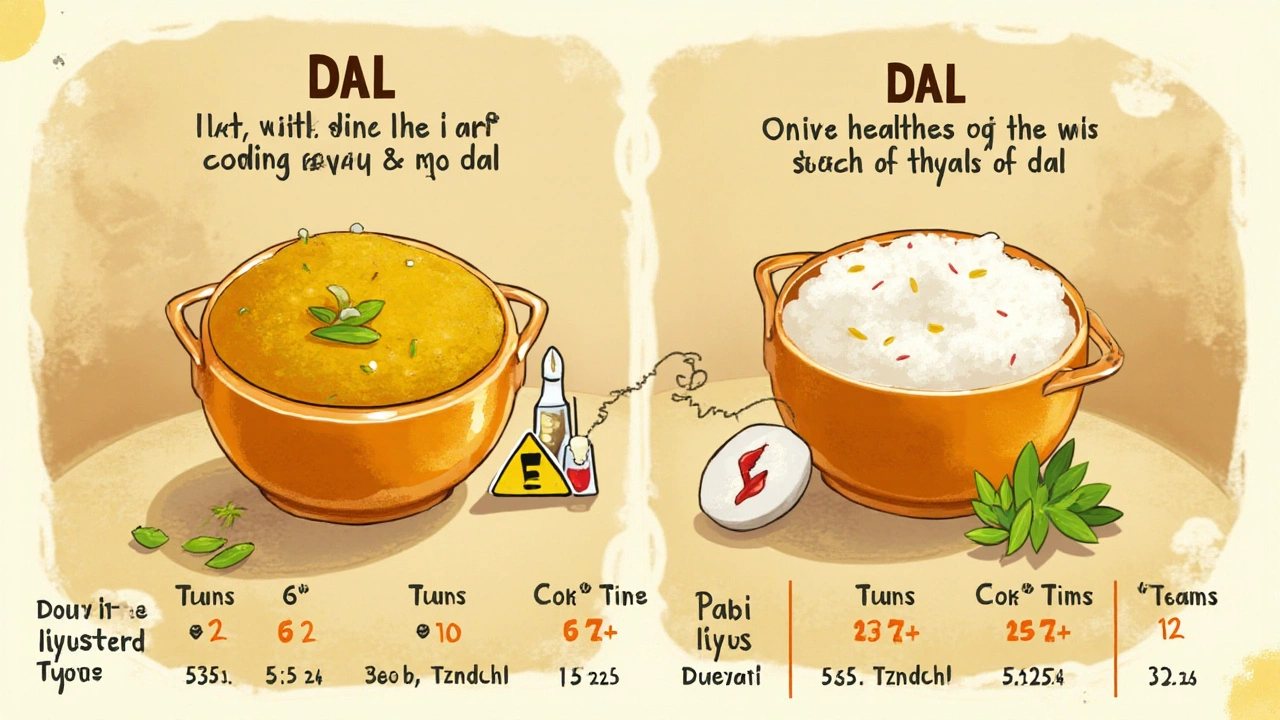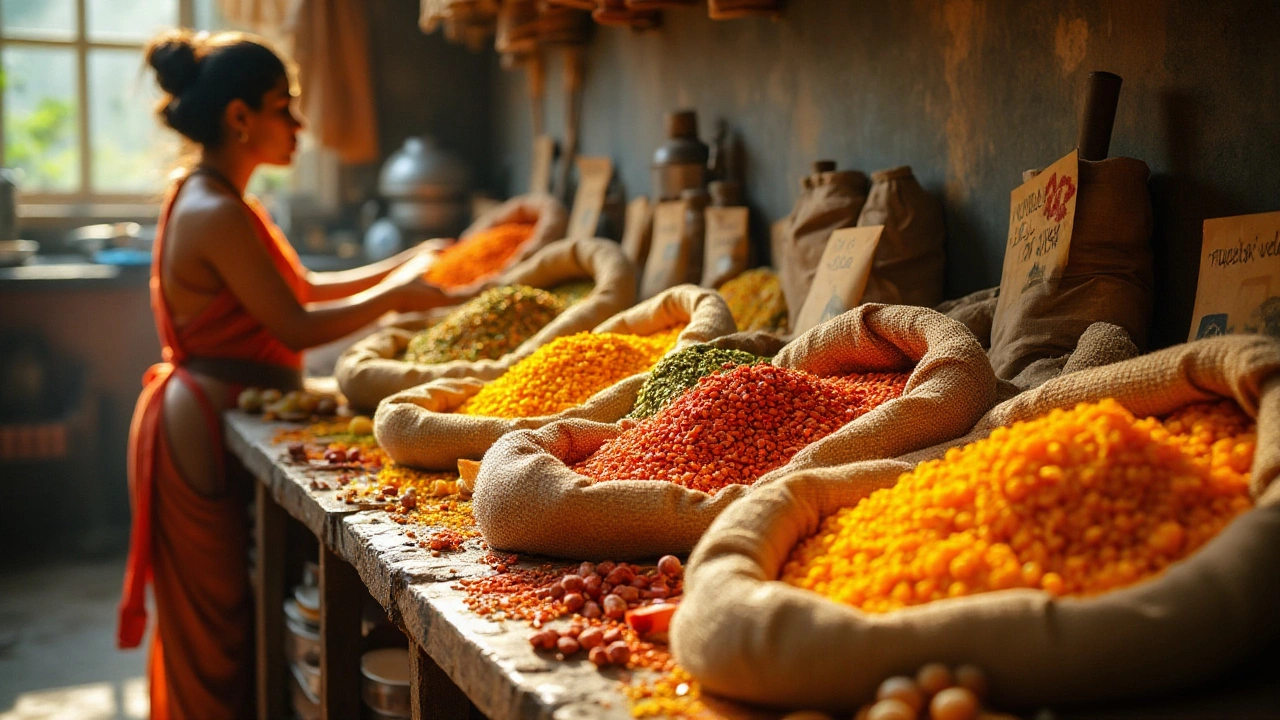6 Jan 2025
- 0 Comments
In the world of legumes, dal stands as a beloved staple across kitchens, with its earthy flavors and filling nature. It's a common sight in many meals, promising not only comfort but also a plethora of nutrients. However, not every dal is the right choice for every dish or diet. Whether you're a seasoned cook or a newbie in the kitchen, making informed choices about your dal can elevate your culinary adventures.
Let's dive into the varieties of dal that you might consider bypassing, either for health reasons or cooking ease. By understanding these nuances, you can tailor your dal dishes to better suit your tastes and nutritional goals. From the kitchens of chefs to the dining tables of families, let's explore which dals deserve a mindful reconsideration in your next meal plan.
- Understanding Varieties of Dal
- Nutritional Considerations
- Cooking Challenges
- Choosing the Right Dal for Your Needs
- Tips for Tasty and Healthy Dal
Understanding Varieties of Dal
Dal, the humble legume, plays a crucial role in many culinary traditions, especially in South Asian households. Its versatility is remarkable—whether simmered into a comforting stew or cooked into a hearty soup, its presence is both celebrated and ubiquitous. There are many varieties of dal, each bringing its own texture, flavor, and nutritional profile to the table. Navigating these varieties requires an understanding of their unique qualities, which can impact both your meal and your health.
Common types of dal include toor dal (pigeon peas), moong dal, masoor dal (red lentils), and urad dal (black lentils). Each of these varieties is suited to different types of cooking methods and dishes. Toor dal, for instance, is often used in traditional Indian sambar and is known for its slightly sweet and nutty flavor. On the other hand, moong dal, with its mild taste and quick-cooking nature, is popular in soups and light dal preparations. These visible differences might seem minor, but each type's properties can transform a dish completely.
Apart from these, there are lesser-known varieties such as horse gram and moth beans, which bring distinct cultural and regional tastes. They often require longer cooking times due to their hardier texture, which might not suit modern fast-paced lifestyles. It's crucial to weigh cooking time against nutritional benefits when choosing which dal to incorporate regularly into your diet. A notable point of discussion is the phytates present in some pulses, which can hinder mineral absorption in the body. This factors into why some health experts recommend diversifying the types of dal you consume.
"Dal is a nutritional powerhouse as long as it is prepared in a way that maximizes its health benefits," notes nutritionist Sarah Williams, highlighting the importance of rotating amongst varieties to avoid nutrient absorption issues.
To better understand the spectrum of choices, one might also consider the uses across different cuisines. In many Indian dishes, opting for certain dal can mean the difference between a creamy consistency versus a chunkier texture. Also, the method of preparation—whether soaked overnight or pressure-cooked—can vary depending on the type of dal, affecting cooking time and flavor extraction. Lentils like chana dal might stand out with their earthy taste, yet they could take longer to become tender compared to small-sized lentils like masoor dal. Such characteristics highlight the functional shifts between dal types.
Finally, sustainability plays into decisions too. Some varieties, more drought-resistant and grown under sustainable farming practices, might be preferred for environmentally-conscious consumers. Understanding dal in this deeper context allows for more than just recipe choices; it's about embracing rich culinary traditions while balancing convenience and nutrition. The choices you make about dal could greatly influence your health and the planet, as every option carries its own story and impact.
Nutritional Considerations
In the realm of dal, different varieties come packed with their own unique nutritional profiles. Some are rich in proteins, while others brim with essential vitamins and minerals. However, it’s crucial to be aware of which dal you should avoid from a nutritional standpoint. For instance, while toor dal is a favorite in Indian households, its high purine content can be a concern for those dealing with gout or kidney issues. High purine levels might potentially elevate uric acid in the body, leading to complications. Understanding these aspects can guide you in making healthier choices for your diet.
On another note, chana dal, a split chickpea variety, is a great source of fiber and can aid in digestive health. Yet, when its carbohydrate content is paired with a diet already high in carbs, it might not be ideal for someone managing diabetes or looking to control weight. Excitingly enough, a little awareness can transform how we approach our daily meals. A study published in the Journal of Nutrition highlighted that incorporating variety in legumes helps maintain balanced nutrition, but paying attention to specific dietary needs is key.
"Dal is both nourishing and delicious, but the magic lies in selecting the right type informed by our body’s requirements," notes the study's lead nutritionist.
For those looking to maximize their protein intake, masoor dal is often celebrated. However, it is vital to know about any anti-nutrients it may contain, such as phytic acid, which can hinder mineral absorption. To combat this, soaking the dal overnight before cooking can reduce these effects significantly, making the nutrients more bioavailable. Now, have you ever considered the role of vitamins? Moong dal, for instance, provides a good amount of vitamins A, C, and E. While it's generally a superb choice, if your diet already includes plenty of these vitamins, you might opt for another type to diversify your nutrient intake.
Considering nutritional implications, it's not merely about maintaining a balanced diet but about understanding the specific needs of your body. Be it protein, fiber, or complex carbohydrates, each dal variety has something to offer. Painstakingly examining your current consumption and contemplating any dietary restrictions can shape more mindful eating habits. A balanced diet is not just a concept; it is a lifestyle choice, aided by knowledge and the right food selections.

Cooking Challenges
Preparing a perfect dal can sometimes feel like an art, and not every type is the same when it comes to cooking. One of the primary challenges is the varied cooking times associated with different types of lentils. For instance, while some lentils like the red lentils (masoor dal) cook rapidly and can turn to a mushy consistency in minutes, others like pigeon peas (toor dal) or black lentils (urad dal) can take significantly longer to soften. This means that using a pressure cooker might be necessary for certain varieties if you're short on time, but it also requires a good understanding of pressure settings to avoid overcooking or undercooking.
The consistency of dal is another point of contention and can vary greatly depending on the type you choose. Some dals, like the split chickpeas (chana dal), tend to maintain a firmer texture and can add body to dishes. In contrast, moong dal breaks down completely, creating a creamy soup-like base. Understanding these textural differences is crucial when you are aiming for a particular consistency in a recipe. If you're looking for a thicker gravy, opting for dals that retain their shape could be beneficial, whereas for a smoother, soupy texture, lentils that break down easily might be preferred.
Another challenge often encountered in cooking dal is the potential for lentils to cause digestive issues, particularly when they are not soaked or cooked thoroughly. Soaking becomes essential, as it not only reduces the cooking time but also helps in breaking down oligosaccharides, which can cause bloating or discomfort. "Dal may be a staple, but it's important to prepare it with care to avoid any gastrointestinal discomfort," suggests nutritionist Rujuta Diwekar in one of her many discussions on traditional Indian cooking techniques. Ensuring adequate soaking and cooking not only enhances digestibility but can significantly improve texture and flavor.
The intricate process of tempering, known as 'tadka', adds another layer of complexity to dal preparation. This involves frying spices in ghee or oil to release their aroma before incorporating them into the dal. The timing and temperature during this step can make a notable difference in the final flavor profile of the dish. Spices like cumin, mustard seeds, and asafoetida can scorch easily if not carefully monitored, altering the taste from aromatic to bitter quickly. Therefore, knowing the correct order and timing for adding spices can transform your dal from bland to brilliant.
In navigating these challenges, tips from experienced cooks and traditional recipes can provide invaluable insights. For instance, using a smaller amount of salt initially and adjusting it towards the end can prevent the dal from toughening while it cooks. Balancing these cooking techniques with individual preferences can take time, making experimentation and patience vital components of mastering dal dishes.
Choosing the Right Dal for Your Needs
When it comes to selecting the right dal, one must consider a range of factors that fit both personal taste and dietary requirements. With numerous varieties like masoor, chana, urad, and toor at your disposal, it's essential to delve deeper into their individual qualities. Each type of dal carries its own distinct flavor, texture, and cooking time—variables that can significantly impact your culinary outcome. For instance, red lentils, known as masoor dal, cook faster than many other types, making them a convenient option for quick meals. Their natural sweetness pairs well with spices, creating a comforting dish. On the other hand, toor dal, or split pigeon peas, have a more robust texture and flavor, often benefiting from longer cooking times to achieve their creamy texture.
Furthermore, considering nutritional profiles is crucial. While all dals are excellent protein sources and nearly packed with essential vitamins and minerals, their nutrient composition may vary. For individuals focusing on iron-rich diets, urad dal can be a commendable choice. It is known for boosting energy levels due to its high iron content. Those monitoring their carbohydrate intake might lean towards dal varieties with a lower glycemic index, such as chana dal, to better manage blood sugar levels.
"Dal is not just a staple; it’s a legacy passed on through generations, intricately woven into the culinary tapestry of various cultures," says renowned nutritionist Dr. Mehta.
For the busy home cook, ease and speed of cooking often take precedence. This is where a deeper understanding of dal cooking techniques proves invaluable. For example, while red lentils relish the role of being quickly boiled to a mush, perfect for soups or thick stews, whole dals like moong might require soaking before cooking to ensure they soften and absorb flavors adequately. Bonus tip: Incorporating a pinch of turmeric not only enhances flavor but also amplifies the health benefits of your dal dishes. To aid digestion and add complexity to flavors, consider adding a tadka—a fragrant topping of spices such as cumin and mustard seeds sizzled in ghee or oil.
Moreover, the versatility of dal makes it a true hero in the kitchen. Try mixing different dal types in one dish to create a layered flavor profile—combining toor and masoor dal is a common blend that enhances both taste and nutrition. Experimenting with spices, herbs, and even vegetables empowers one to alter traditional recipes, transforming simple dal dishes into gourmet delights. For those intrigued by fusion cooking, incorporate international flavors like coconut milk or miso to lend an exotic twist to the routine dal dish.
Choosing the perfect dal requires balancing personal dietary needs, familial preferences, and time constraints. Ultimately, equipping yourself with the knowledge about each dal type unlocks an infinite realm of flavors and possibilities. Remember, the journey into the world of dal is as enjoyable as savoring the dish itself, and with the right approach, it becomes a cherished culinary experience.

Tips for Tasty and Healthy Dal
Creating delicious and nutritious dal is a joy that comes from understanding the pulse you're working with and knowing the cooking nuances that will bring out its best flavors. Perhaps the most fundamental step is selecting fresh lentils. Older lentils tend to be drier and take longer to cook, which can compromise their taste and texture. Always store your dal in airtight containers to preserve freshness, and once you're ready to cook, rinse them thoroughly. This is crucial since it not only removes dust but also reduces the natural chemicals that might cause bloating or indigestion.
Seasoning plays a pivotal role in dal preparation. The right balance of spices can transform a simple dish into a soulful experience. Begin with tempering, a technique often used in Indian cooking where spices are toasted in hot oil or ghee to release their flavors. Commonly used spices include cumin seeds, turmeric, and mustard seeds. As the oil heats up, add curry leaves or dried red chilies to enhance the aromatic profile of your dish. Remember, the use of turmeric is particularly beneficial as it not only adds vibrant color but also brings anti-inflammatory properties to the dish.
Certain cooking practices can also make your dal recipes more wholesome. Consider using vegetable broth instead of water for a deeper flavor. A pressure cooker or Instant Pot can be your best friend when cooking dal, significantly cutting down on time and retaining more nutrients. If one prefers the stovetop method, simmer the lentils with partially closed lids; this will help avoid mess while allowing steam to escape. Stir occasionally and keep an eye out for scum forming on top, which can be skimmed off to ensure a clear broth.
Adding vegetables to your dal not only complements the flavor but also boosts nutritional content. Spinach, kale, and carrots are popular choices. If you crave a bit of tartness, a splash of lemon juice or tamarind pulp can lift the dal's profile. A dollop of ghee at the end, while entirely optional, can enrich the taste, making it an irresistible pleasure. Remember not to over-salt. It is always best to add it towards the end of cooking since salt can firm up the lentils during cooking, which might prolong the process unnecessarily.
The serving of dal is just as important as its preparation. Pair it with freshly cooked basmati rice or warm chapatis, and consider garnishing with fresh cilantro or green chili slices for added zest. For an authentic touch, serve it with a side of tangy pickle or simple yogurt to balance the heat and spices, creating a well-rounded meal. As the culinary expert and cookbook author Madhur Jaffrey puts it,
‘Good dal is more than just lentils—it is love packed into a bowl.’With these tips in mind, you are sure to create a dal that is both flavorful and fulfilling, promising a nutritious addition to any meal.
